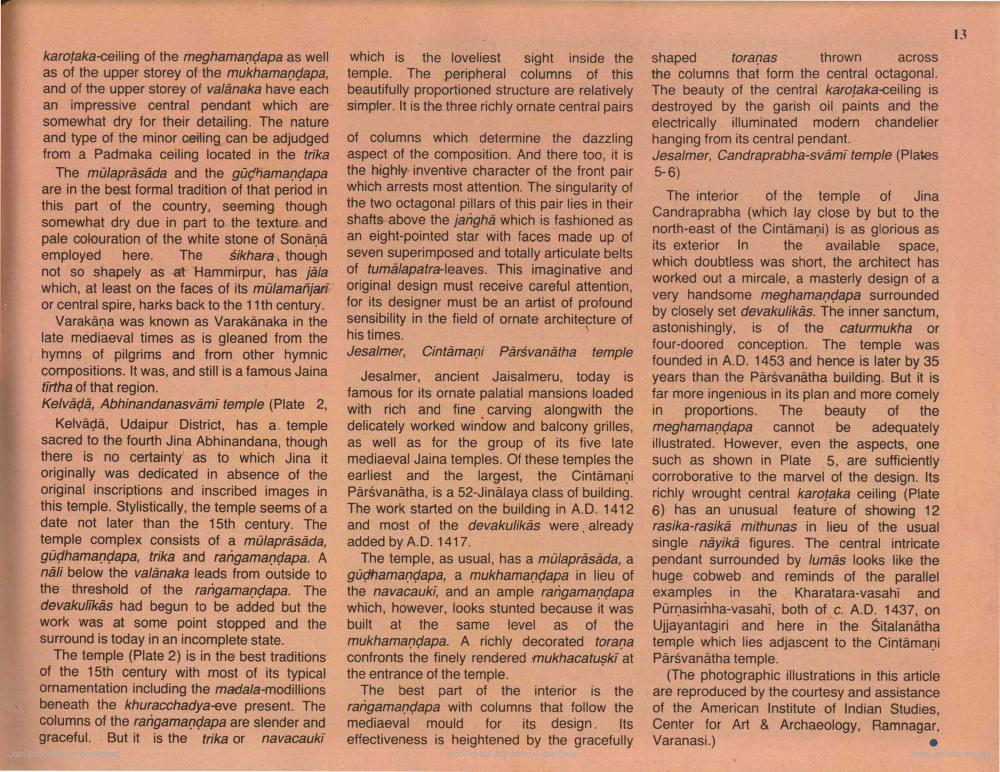________________
karotaka-ceiling of the meghamandapa as well as of the upper storey of the mukhamandapa, and of the upper storey of valánaka have each an impressive central pendant which are somewhat dry for their detailing. The nature and type of the minor ceiling can be adjudged from a Padmaka ceiling located in the trika
The mülaprasada and the güchamandapa are in the best formal tradition of that period in this part of the country, seeming though somewhat dry due in part to the texture and pale colouration of the white stone of Sonänä employed here. The Sikhara, though not so shapely as at Hammirpur, has jala which, at least on the faces of its mulamanjari or central spire, harks back to the 11th century.
Varakana was known as Varakanaka in the late mediaeval times as is gleaned from the hymns of pilgrims and from other hymnic compositions. It was, and still is a famous Jaina tirtha of that region. Kelvādā, Abhinandanasvami temple (Plate 2,
Kelvada, Udaipur District, has a temple sacred to the fourth Jina Abhinandana, though there is no certainty as to which Jina it originally was dedicated in absence of the original inscriptions and inscribed images in this temple. Stylistically, the temple seems of a date not later than the 15th century. The temple complex consists of a mulaprasada, gudhamandapa, trika and rangamandapa. A nali below the valánaka leads from outside to the threshold of the rangamandapa. The devakulikās had begun to be added but the work was at some point stopped and the surround is today in an incomplete state.
The temple (Plate 2) is in the best traditions of the 15th century with most of its typical ornamentation including the madala-
modillions beneath the khuracchadya-eve present. The columns of the rangamandapa are slender and graceful. But it is the trika ornavacauki
which is the loveliest sight inside the shaped toranas thrown across temple. The peripheral columns of this the columns that form the central octagonal. beautifully proportioned structure are relatively The beauty of the central karotaka-ceiling is simpler. It is the three richly ornate central pairs destroyed by the garish oil paints and the
electrically illuminated modern chandelier of columns which determine the dazzling hanging from its central pendant aspect of the composition. And there too, it is Jesalmer, Candraprabha-svami temple (Plates the highly inventive character of the front pair 5-6) which arrests most attention. The singularity of
The interior of the temple of Jina the two octagonal pillars of this pair lies in their
Candraprabha (which lay close by but to the shafts above the jangha which is fashioned as
north-east of the Cintamani) is as glorious as an eight-pointed star with faces made up of
its exterior In the available space, seven superimposed and totally articulate belts
which doubtless was short, the architect has of tumalapatra-leaves. This imaginative and
worked out a mircale, a masterly design of a original design must receive careful attention,
very handsome meghamandapa surrounded for its designer must be an artist of profound
by closely set devakulikäs. The inner sanctum, sensibility in the field of ornate architecture of
astonishingly, is of the caturmukha or his times.
four-doored conception. The temple was Jesalmer, Cintamani Parsvanátha temple
founded in A.D. 1453 and hence is later by 35 Jesalmer, ancient Jaisalmeru, today is years than the Parsvanātha building. But it is famous for its ornate palatial mansions loaded far more ingenious in its plan and more comely with rich and fine carving alongwith the in proportions. The beauty of the delicately worked window and balcony grilles, meghamandapa cannot be adequately as well as for the group of its five late illustrated. However, even the aspects, one mediaeval Jaina temples. Of these temples the such as shown in Plate 5. are sufficiently earliest and the largest, the Cintamani corroborative to the marvel of the design. Its Parsvanátha, is a 52-Jinalaya class of building. richly wrought central karotaka ceiling (Plate The work started on the building in A.D. 1412 6) has an unusual feature of showing 12 and most of the devakulikäs were already rasika-rasikā mithunas in lieu of the usual added by A.D. 1417
single näyika figures. The central intricate The temple, as usual, has a mülaprasada, a pendant surrounded by lumas looks like the gudhamandapa, a mukhamandapa in lieu of huge cobweb and reminds of the parallel the navacauki, and an ample rangamandapa examples in the Kharatara-vasahi and which, however, looks stunted because it was Purnasimha-vasahi, both of c. A.D. 1437, on built at the same level as of the Ujjayantagiri and here in the Sitalanātha mukhamandapa. A richly decorated torana temple which lies adjascent to the Cintamani confronts the finely rendered mukhacatuski at Parsvanatha temple. the entrance of the temple.
(The photographic illustrations in this article The best part of the interior is the are reproduced by the courtesy and assistance rangamandapa with columns that follow the of the American Institute of Indian Studies, mediaeval mould for its design. Its Center for Art & Archaeology. Ramnagar, effectiveness is heightened by the gracefully Varanasi.)




